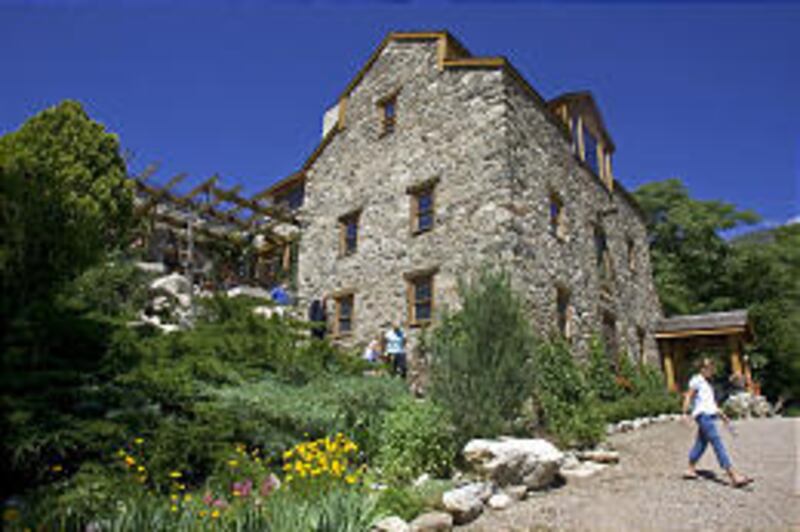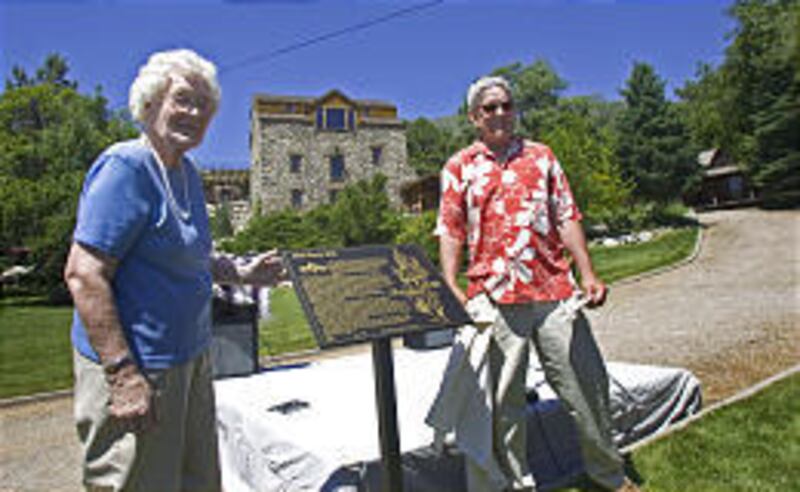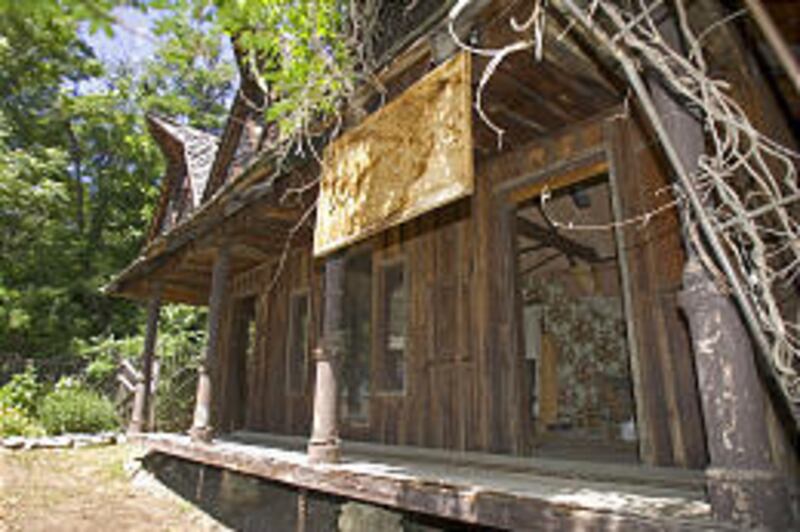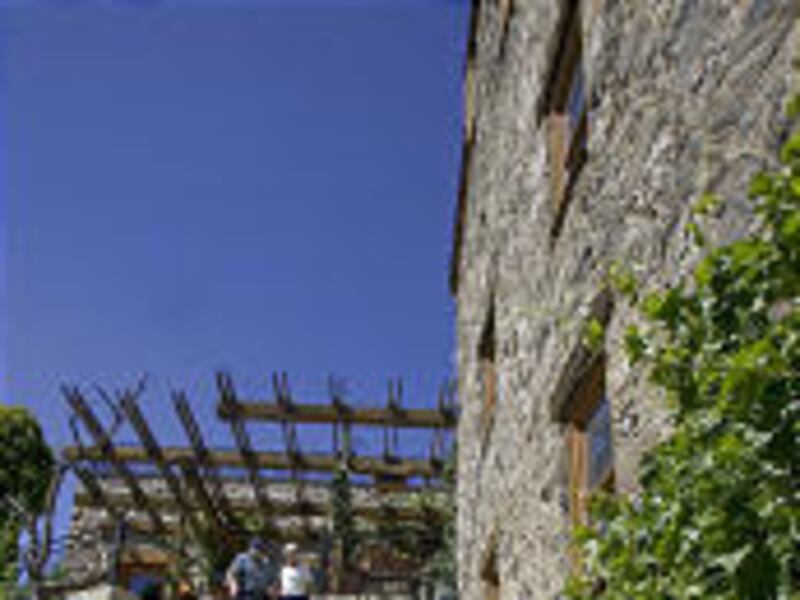FARMINGTON — Tom Owens, owner of the old Rock Grist Mill in Farmington, said people stop by his property all the time to take a stroll down memory lane.
Saturday, June 18, they came to reminisce and watch as the Daughters of Utah Pioneers dedicated a plaque on the site at 700 N. Rock Mill in Farmington.
"This place is a very fond spot for many, many people in Utah," Owens said.
Zelda Tidwell of Farmington has fond memories of dances and dinners at the site with friends from work.
"This one couple, Bob and Kay Christensen, one night came to pick me and my date, Neal Giles, up," Tidwell said. "We rode in the back of a pickup on lawn chairs. I had a formal dress and high heels on. It was really fun."
Annette Tidwell, Zelda's daughter and executive director of the Farmington Historical Museum, remembers working in a gift shop on the property. She said the shops sold European crystal, cookies, candies and pumpernickel bread baked at the mill.
"It was always a place we came to for a really special, pricey dinner," Tidwell said about a restaurant that was on the site.
Owens has spent the past 12 years stabilizing and restoring the old Rock Grist Mill building after it was badly vandalized.
"Throughout the whole Salt Lake and Ogden valleys, it was known as a place to go to tear things up and destroy things there," Owens said.
The Daughters of Utah Pioneers originally put a plaque on the site in 1965, but vandals took it in the early 1990s. The new plaque will eventually be placed on a rock pillar so people can read and see it from their cars.
"The Daughters of Utah Pioneers not only go around putting plaques on buildings and historical sites, they're keepers of the past," Owens said. "They keep our heritage alive."
Owens said the mill is the most significant LDS historic building in private hands anywhere. He said it is by far the most important building in Davis County history.
"What a pleasure to sit here and look up at the Rock Mill," said Glen Leonard, LDS Church historian. "The Daughters of Utah Pioneers have cared about it, marked it, taught and talked about it."
The three-story rock building was designed and built from 1857-60 by Frederik Kesler.
"When the pioneers first came to the Salt Lake Valley to establish the communities, their primary needs were someplace to live and something to eat," Leonard said.
Willard Richards, an early LDS apostle, was sent to the Farmington area by early LDS President Brigham Young. He was assigned to care for and settle the land near the North Cottonwood Creek. Richards decided to build a small mill in the Farmington area in 1852, but after he passed away in 1854, his nephew, Franklin D. Richards, decided to build another larger mill.
The Rock Grist Mill was dedicated on June 19,1862, by Franklin D. Richards, also an early LDS apostle.
"My ancestors helped build the mill," said Elder H. Bryan Richards, great-great-grandson of Franklin D. Richards, a member of the Second Quorum of Seventy. "They lived here for a time. They were pioneers in their own community."
Richards dedicated the plaque during the DUP ceremony held 143 years after his great-great-grandfather dedicated the mill.
"I'm honored to be here today," Richards said. "It's a special event to me personally."
From the 1860s-90s the mill worked grinding wheat, corn and grain with a water pump.
Zelda Tidwell, said her great-great-grandfather James Cowley came from the Isle of Man to work at the mill.
"He was brought here by Willard Richards to teach the Saints how to make oatmeal," Tidwell said. "For many, many years it fed many people in town."
Flour from the mill was sold to local residents and grist was fed to chickens, pigs, cows and horses.
"It was a very important part of the economy; it was an important part of the food chain," Owens said. "That's what they lived on. That's what they ate."
In the 1890s, steam-powered mills made their way to Utah, and the Rock Grist Mill closed down. In 1906 it was converted into one of Farmington and Davis County's first electric generating stations. Some of the power generated from the mill was used for the Bamberger Railroad — an electric train that ran from Salt Lake City to Ogden.
The mill remained vacant from the 1920s to 1950s except for occasional families of the owners who would live off and on in the lower floor.
From 1960-90 a German-style restaurant, the Heidelberg, found a home in the mill.
"The Heidelberg restaurant was the most popular eating spot on the Wasatch Front," said Mary Johnson, International DUP president. "We heard about it a long time before we could afford to eat there."
Bob and Marlene Hasenyager of Farmington remember a date they spent at the restaurant early on in their marriage.
"It was really good food," Marlene said. "We ate on the second floor. You had to walk around the grinding stone to get upstairs."
Owens said people flocked to the Heidelberg for proms, weddings and LDS missionary farewells.
After the Heidelberg closed in 1990, the site remained vacant until Owens purchased it at a state auction in 1992.
Owens said that he thinks the LDS Church will end up owning the site and turning it into a museum.
"It is such an important historic artifact," Owens said. "It's like a museum piece; it's like the ultimate antique."
Leonard said the mill site is a treasure for Farmington and the state of Utah. Pictures of the mill can be seen at rockmill.com.
"It's nice to have people who are so interested in preserving history," Johnson said. "We're so thankful for Tom."
E-mail: nclemens@desnews.com






